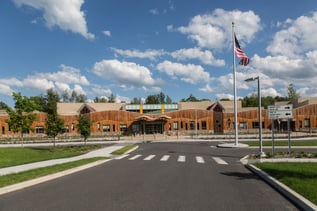I recently joined a school security assessment team for a newly constructed elementary school. The design reflected modern trends emphasizing transparency, openness, creativity, and collaboration in education. Reflecting on the elementary school I attended (50 years ago!), I was struck by the differences between my childhood school and the school I recently visited. The two facilities look different. The concrete walls of my school have been replaced by glass, both on the outside and throughout the interior, including floor-to-ceiling glass walls in the media center, cafeteria, and classroom pods.
The new school’s classroom pods contain collaborative areas for small group learning, art supplies, a sink, whiteboards, and other features to engage the students and promote collaboration and multisensory learning. The two-story media center and cafeteria were designed as open spaces, with big glass and windows overlooking the hallways and exterior. The media center includes a second-story art room and an open walkway around the perimeter of the space, where there are areas for students to sit and read or to collaborate in small groups. Corridors are open and expansive, allowing ample room for students and staff. In addition, shared sinks are located in the hallway outside the boys’ and girls’ bathrooms, limiting time spent in the restrooms and making it easier for staff to monitor student activity.
The corridors in my elementary school were filled with lockers and were simply the path we took from point A to point B. Classrooms had few windows and were filled with rows of desks facing the teacher’s desk in the front. Quite a dramatic difference from this modern school design!
While fascinated by the design of the new school, my immediate thought was that students in glass-walled classrooms could quickly become targets in an active shooter event. More injuries could occur due to the amount of glass, and there are few places to hide. As security consultants, we must consider the horrible activities that could happen in schools, even if the chances are remote. To reduce risk, the elementary school we were assessing would need to be redesigned entirely – and that will never happen.
Transparency in school design is here to stay. But some elements, like glass-walled classrooms, are controversial when placing students at risk. Given such concerns, I have sought to balance the design trend of transparency and the need to provide for the safety of students and staff.
As more modern schools are designed, here are some tips for balancing openness and security:
Proactive Security
Most forms of school security are passive. Cameras can be deployed throughout the school, but they generally record a situation for evaluation later instead of alerting school personnel of a potential threat. Rarely do schools have dedicated security personnel constantly monitoring cameras. Duress alarms and lockdown procedures are also reactive security techniques designed to respond to an incident in progress or one that has already occurred. Proactive measures can alert school personnel before or at the onset of an incident. Examples of proactive security include:
- Analytic Cameras – cameras that use artificial intelligence to look for patterns, such as vehicles or people entering the parking lot after school is in session, or suspicious items, such as a backpack left unattended in the school lobby. The cameras are designed to alert school personnel of a potential threat. There is usually no actual threat, but the camera at least alerts school personnel that something is out of the ordinary. Security personnel or school staff can then assess the situation and respond accordingly.
- Gunshot Detection - gunshot detection technology is based on sound waves and is highly accurate. It will not mistake a slammed locker, dropped book in the hallway, or backfire in the parking lot as a gunshot. Even though a gun would have to go off to engage this technology, I label it as proactive because it will immediately notify authorized personnel and emergency responders, potentially saving valuable seconds or minutes. While there isn’t foolproof security for someone willing to surrender their own life to take the lives of others, gunshot detection technology can minimize injury and loss of life. Such technologies are powerful enough to alert authorized personnel quickly, but they can also be tied to automatic door-locking mechanisms and security camera tracking. (Example - Amulet)
Covering the Glass Wall
Because the glass-walled classrooms of modern education present a security risk, some measures can be taken to add a level of protection while preserving the desired openness. I have seen some teachers use a frosting spray on the lower portions of the glass wall to block the view, and others have taped artwork to the glass. However, such attempts to block the view look somewhat chaotic and do not complement the design. For this reason, blinds that drop from the ceiling or a curtain that can be pulled across the glass wall (this is probably the fastest method) can obstruct vision and keep the classroom occupants safe. There are even materials emerging in the market for bullet-resistant curtains and drop-downs – though currently pricey, the cost of such materials has been dropping over time.
Classroom Pods
As mentioned earlier, many of the new school designs place classrooms in pods or groups centered around an area for collaboration and multisensory learning. Each pod has a hallway, and the classrooms are designed on each side of the hall. Because a pod has an individual hallway, some designs automatically lock the hallway doors so that a pod can be sealed off to prevent unauthorized entry.
Hardened Stairwells
Building upon the point above, such pods can be designed with stairwells on the exterior wall. The stairwells can be hardened with wall construction and film on glass windows. If there is a shooting threat at the school, students can move from their classroom to the stairwell to hide in a secure area with significant ballistic resistance. Of course, another emerging trend is to have big glass in stairwells. In this case, bullet-resistant film or other glass treatment would be needed to harden the stairwell.
Defining the Balance
The recommendations above can be used to reduce risk in modern school design. One of the school designs that has impressed me is the new Sandy Hook Elementary School. Despite the tragic shooting at Sandy Hook, the school personnel, students, and community came together to design an open and inviting new school. This beautiful facility embraces nature and the transparency of modern school design. In three key ways, the design strikes a balance between openness and promoting security:
- Setting the school off the main road in a woodland environment
- Controlling access to the drive leading to the school with gates and a security booth when the school is in operation
- Designing natural areas with wetland features around the perimeter with footpaths across bridges that channel students into the school

Sandy Hook Elementary School - Newtown, Connecticut
These features are just a few security measures used in the new design. I highlight them here because they are firmly rooted in Crime Prevention through Environmental Design. They also underscore that controlling who can get close to the school is the best way to promote security. This control contributes to feelings of safety and allows the school to be designed in an open and nature-promoting fashion. The school administrators and designers could have reacted to the shootings by creating an impenetrable fortress. Still, they chose an open-school design with well-thought-out and less intrusive security features.
Modern school design, with all of its openness and glass, contributes so much to the well-being of students. Though this design has risks, those risks can be reduced with good design and more proactive security measures.






-1.jpg)
.jpg)
.jpg)
.jpg)
-2.jpg)
.jpg)


.jpg)
.jpg)
.jpg)
.jpg)
.jpg)

